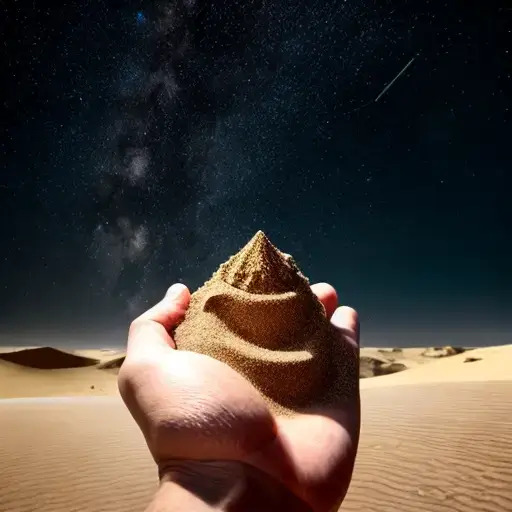How Many Atoms in a Grain of Sand? Compared to Stars and Other Things? Atoms are the building blocks of everything — but they’re so small, they’re invisible to the naked eye. That leads to some wild claims, like:
“There are more atoms in a single grain of sand than stars in the universe!”
Sounds unbelievable? In this post, we’ll:
- 🔬 Break down how many atoms are in a grain of sand
- 🌌 Compare that to the number of stars in the cosmos
- 🏖 See how Earth’s sand and your own body stack up atomically
Let’s dive into the microscopic world to separate fact from fiction.
Atoms vs. Stars vs. Sand

Quick Summary:
- One grain of sand (~0.1 mm) contains about 4.17 × 10¹⁶ atoms — that’s 41,700,000,000,000,000 or 41 quadrillion atoms
- The observable universe has an estimated 10²² stars — that’s 10 sextillion stars
- Earth has roughly 7.5 × 10¹⁸ grains of sand — that’s 7.5 quintillion grains
- A human body contains about 7 × 10²⁷ atoms — or 7 octillion
How Many Atoms Are in a Grain of Sand?
To find out how many atoms are in a grain of sand, we need to start by understanding the grain’s size, composition, and scale compared to an atom.
What Is Sand Made Of?
Most sand grains are composed of silicon dioxide (SiO₂) — the same substance found in quartz and glass, made of 1 silicon and 2 oxygen atoms.
Grain vs Atom
An average grain is about 0.1 mm wide (100,000 nanometers), while a single atom is just 0.3 nanometers across. That means an atom is about 300,000 times smaller than a grain of sand.
The Calculation
Let’s break it down:
- Grain radius: 0.05 mm = 0.005 cm
- Volume: V = (4/3)πr³ ≈ 5.24 × 10⁻⁷ cm³
- Density of SiO₂: 2.65 g/cm³
- Mass: 5.24e‑7 × 2.65 ≈ 1.39 × 10⁻⁶ g
- Molecular weight of SiO₂: 60.08 g/mol
- Moles of SiO₂: 1.39e‑6 / 60.08 ≈ 2.31 × 10⁻⁸ mol
- Molecules: 2.31e‑8 × 6.022e²³ ≈ 1.39 × 10¹⁶ molecules
- Total atoms: Each SiO₂ has 3 atoms → 1.39e16 × 3 ≈ 4.17 × 10¹⁶ atoms
In words: That’s about 41.7 quadrillion atoms inside a single grain of sand.
Fun visual: If each atom were the size of a grain of rice, they’d fill an entire Olympic-sized swimming pool!
Sand vs Other Things: Atom Count Comparison
Things With More Atoms
- Sugar crystal: 10²³–10²⁴ atoms (100 sextillion – 1 septillion)
- Salt crystal: 10¹⁸–10²¹ atoms (1 quintillion – 1 sextillion)
- Human body: ~7 × 10²⁷ or 7 octillion atoms
Things With Fewer Atoms
- Pollen grain: ~10⁵–10⁶ atoms (100,000 – 1 million)
- Dust particle: ~10³–10⁶ atoms (1,000 – 1 million)
- Single DNA molecule: ~10⁹–10¹⁰ atoms (1 billion – 10 billion)
Stars vs. Atoms in Sand
The observable universe has about 10²² stars — that’s 10,000,000,000,000,000,000,000 or 10 sextillion stars.
Compare that to the 41 quadrillion atoms in a grain of sand, and stars easily win. There are roughly 240,000× more stars than atoms in a single grain of sand.
Earth's Sand Supply vs a Single Grain
Earth is estimated to have around 7.5 × 10¹⁸ grains of sand — that’s 7,500,000,000,000,000,000 grains, or 7.5 quintillion.
That means Earth holds about 180,000 times more grains than there are atoms in one grain of sand.
Powers of Ten — What Do These Numbers Mean?
| Scale | Number | Power of 10 |
|---|---|---|
| Thousand | 1,000 | 10³ |
| Million | 1,000,000 | 10⁶ |
| Billion | 1,000,000,000 | 10⁹ |
| Trillion | 1,000,000,000,000 | 10¹² |
| Quadrillion | 1,000,000,000,000,000 | 10¹⁵ |
| Quintillion | 1,000,000,000,000,000,000 | 10¹⁸ |
| Sextillion | 1,000,000,000,000,000,000,000 | 10²¹ |
| Octillion | 1 followed by 27 zeros | 10²⁷ |
Common Misconceptions
- More atoms in a grain of sand than stars? False — there are many more stars in the universe.
- Are there more grains than atoms? Yes — the number of grains on Earth outnumbers the atoms in one grain.
- All grains are the same? No — composition and size can vary greatly.
FAQ
How many grains of sand are on Earth?
About 7.5 quintillion — 7.5 × 10¹⁸ grains.
Are there more atoms in a grain of sand than stars in the universe?
No. A grain has about 41 quadrillion atoms, while the universe holds about 10 sextillion stars — vastly more.
How many atoms are in a single grain?
Approximately 4.17 × 10¹⁶, or 41.7 quadrillion atoms.
What makes up a grain of sand?
Mostly SiO₂ — silicon and oxygen atoms combined into silicon dioxide.
How does the human body compare?
The human body contains around 7 octillion atoms (7 × 10²⁷) — far more than in a single grain of sand.
What has more atoms than a grain of sand?
- Salt crystals
- Sugar cubes
- Living cells
- You — a human being!
Final Thoughts: From Tiny to Cosmic
Whether it’s a speck of sand or the starry sky, numbers like these stretch our imagination. Atoms are unfathomably small — yet they make up everything we see and touch. Understanding them helps us see both the miracle of the minuscule and the awe of the infinite.